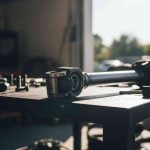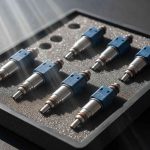Understanding the Critical Role of Harmonic Balancers
The harmonic balancer, also known as a crankshaft damper or pulley, serves as your engine’s primary defense against destructive torsional vibrations. Bolted directly to the front end of the crankshaft, this vital component acts as a torsional shock absorber that prevents catastrophic engine damage.
When pistons fire during combustion, they send sharp twisting forces through the crankshaft, causing it to twist slightly before springing back. The harmonic balancer consists of an inertia mass (outer ring) and an energy-dissipating element typically made of rubber or fluid that counteracts these forces and converts harmful vibrations into harmless heat.
- Prevents crankshaft damage that could lead to fatigue or catastrophic failure
- Maintains precise timing for camshaft and ignition systems
- Reduces wear on other engine parts
- Improves comfort by minimizing cabin vibrations
Warning Signs of a Failing Harmonic Balancer
Recognizing the symptoms of a failing harmonic balancer early can save you from expensive engine repairs. A compromised balancer loses its ability to dampen vibrations effectively, leading to cascading problems throughout your engine system.
| Symptom Category | Specific Indicators |
|---|---|
| Vibration/Feel | Excessive engine vibrations that increase at higher speeds, pulsing through steering wheel or seat at certain RPMs |
| Visual Damage | Visible wobble of pulley when engine runs, separation between inner hub and outer ring, cracks or bulging rubber |
| Noise Issues | Unusual knocking, rattling, or squeaking that varies with engine speed, belt slap sounds |
| Accessory Problems | Belt misalignment leading to slipping or failure, worn accessory brackets |
| Timing Issues | Timing marks slipping out of index, misfires, poor performance |
| Oil Leaks | Front main seal leaks caused by crooked balancer movement |
Research indicates that stock elastomer balancers deteriorate due to heat generation, oil exposure, excessive power, or improper installation. Even low-mileage units can fail if they’ve been exposed to harsh conditions over time.
Finding Quality Used Harmonic Balancers
When searching for a replacement harmonic balancer, salvage yards near you offer cost-effective OEM alternatives to expensive new parts. However, finding the right part requires knowledge of where to look and what to inspect.
Start by identifying your vehicle’s specific requirements using the VIN number and engine specifications. Harmonic balancers are typically engine-specific, so compatibility is crucial for proper fitment and function.
- Check multiple yards for the best selection and prices
- Verify part numbers match your vehicle’s specifications
- Ask about return policies before making your purchase
- Consider newer model years for better rubber condition
Many salvage yards now maintain online inventories, allowing you to search for specific parts before visiting. This saves time and ensures availability before making the trip.
Comprehensive Inspection Checklist
Thorough inspection of a used harmonic balancer is critical before installation. Age and exposure can degrade rubber components even on low-mileage vehicles, making visual and physical inspection your best defense against purchasing a failing part.
Rubber Insulator Ring Assessment
The rubber insulator ring serves as the heart of the vibration damping system. Any deterioration here compromises the entire unit’s effectiveness.
- Surface cracks: Look for hairline cracks around the circumference or where rubber meets metal
- Dry rot indicators: Check for brittle, flaking, or chalky rubber surfaces
- Color changes: Healthy rubber maintains consistent coloring; avoid parts with significant discoloration
- Flexibility test: Gently press the rubber – it should have some give, not feel hard or brittle
Separation and Delamination Checks
Separation between the inner hub and outer ring indicates catastrophic failure of the damping system. This inspection requires careful visual examination from multiple angles.
| Inspection Point | What to Look For | Why It Matters |
|---|---|---|
| Hub-to-Ring Gap | Any visible separation or unevenness between inner hub and outer ring | Indicates complete dampening failure and dangerous wobble potential |
| Alignment Test | Paint line across hub, rubber, and ring should remain straight after rotation | Confirms rubber bond integrity under load conditions |
| Visual Runout | Side-to-side movement when spinning by hand | Reveals internal separation or bent components |
Mounting Surface and Hardware Inspection
The mounting surfaces and hardware must be in perfect condition to ensure secure installation and prevent future failures.
- Keyway integrity: The slot must be clean, undamaged, and properly sized
- Bolt hole condition: Check for elongation, cracks, or galling from over-tightening
- Timing mark clarity: Ensure marks are visible and not obscured by rust or damage
- Surface corrosion: Light surface rust is acceptable, but avoid deep pitting or structural corrosion
Advanced Testing Techniques
Beyond visual inspection, several advanced techniques can help verify a used harmonic balancer’s condition before purchase.
The Paint Line Test
This simple but effective test reveals internal rubber bond integrity that may not be visible externally.
- Mark a straight line across the hub, rubber, and outer ring with a paint pen
- If possible, simulate rotation or brief operation
- Check if lines remain perfectly aligned
- Any misalignment indicates internal slippage
Professional Runout Measurement
For critical applications, consider having the part checked with a dial indicator to measure precise runout specifications. Most harmonic balancers should have less than 0.005 inches of runout when properly mounted.
What to Avoid When Shopping
Certain red flags should immediately disqualify a used harmonic balancer from consideration, regardless of price or availability.
- Visible oil saturation: Oil-soaked rubber has lost its damping properties
- Impact damage: Dents, gouges, or bent components compromise balance
- Welded repairs: Any welding indicates previous failure and unsafe condition
- Missing timing marks: Essential for proper installation and timing
- Aftermarket modifications: Non-OEM modifications may not provide proper damping
Remember that research shows that elastomer-based balancers degrade over time regardless of mileage, making age a critical factor in your decision.
Installation Considerations and Best Practices
Once you’ve found a quality used harmonic balancer, proper installation is crucial for optimal performance and longevity.
Pre-Installation Steps
- Clean all surfaces thoroughly before installation
- Verify crankshaft condition and check for damage
- Use proper installation tools to avoid damage during mounting
- Apply appropriate torque specifications according to manufacturer guidelines
Post-Installation Monitoring
After installation, monitor your engine for signs of proper harmonic balancer function:
- Smooth idle: No unusual vibrations at idle or under load
- Belt alignment: Proper tracking without excessive wear
- No unusual noises: Absence of rattling or grinding sounds
- Stable timing: Consistent ignition timing readings
When to Choose New Over Used
While used harmonic balancers can provide excellent value, certain situations warrant purchasing new parts instead.
High-performance applications or rebuilt engines often benefit from new fluid-filled dampers that offer superior heat dissipation and damping compared to standard OEM elastomer units.
- High-mileage engines: Consider new parts for engines with over 150,000 miles
- Performance modifications: Increased power requires upgraded damping capacity
- Critical applications: Commercial or emergency vehicles need maximum reliability
- Repeated failures: Multiple balancer failures may indicate need for upgraded design
Cost-Benefit Analysis
Understanding the true cost of used versus new harmonic balancers helps make informed purchasing decisions.
| Factor | Used Part | New Part |
|---|---|---|
| Initial Cost | $25-75 | $150-400 |
| Expected Lifespan | 2-5 years | 8-12 years |
| Warranty Coverage | 30-90 days | 1-3 years |
| Installation Risk | Moderate | Low |
If your vehicle is older or you’re planning to sell your car in the near future, a quality used harmonic balancer represents excellent value. For newer vehicles or those you plan to keep long-term, new parts may provide better overall value despite higher upfront costs.
Seasonal Considerations
Timing your harmonic balancer replacement can affect both availability and cost at salvage yards.
- Winter months: Higher inventory from weather-related accidents
- Spring cleaning: Increased turnover as people clear old vehicles
- Summer heat: More engine failures increase part availability
- Holiday periods: Potential discounts during slower sales periods
Environmental and Economic Benefits
Choosing used harmonic balancers contributes to environmental sustainability while providing economic advantages.
Reusing functional parts reduces manufacturing demand, conserves raw materials, and prevents usable components from entering waste streams. Environmental research shows that automotive recycling significantly reduces the carbon footprint associated with new part manufacturing.
- Reduced manufacturing emissions from avoided new production
- Conservation of raw materials including steel and rubber
- Economic support for local recycling businesses
- Cost savings that can be invested in other vehicle maintenance
Final Recommendations
Successfully finding and inspecting a used harmonic balancer requires patience, knowledge, and careful attention to detail. The comprehensive inspection process outlined above helps ensure you select a part that will provide reliable service while saving money compared to new alternatives.
Remember that harmonic balancers are critical safety components that affect engine longevity and performance. When in doubt, consult with experienced mechanics or consider upgrading to new parts for peace of mind. The investment in proper inspection and quality parts pays dividends in avoided repairs and enhanced vehicle reliability.
Whether you’re maintaining a daily driver or restoring a classic vehicle, understanding how to properly evaluate used harmonic balancers empowers you to make informed decisions that balance cost, quality, and safety considerations effectively.





Leave a Reply
You must be logged in to post a comment.